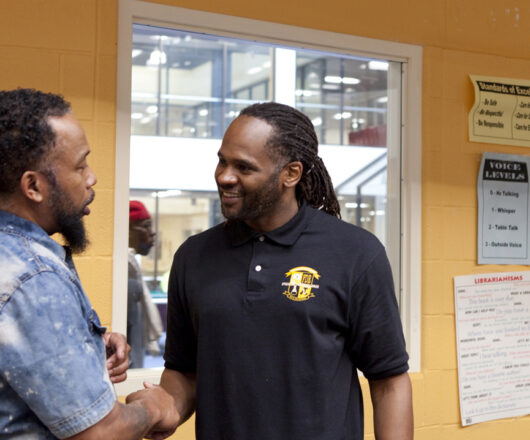

December 12, 2017
Power of the Plan: ‘Wrapping’ communities with support — at school and beyond
Power of the Plan: ‘Wrapping’ communities with support — at school and beyondStory by Justin Glanville Photos by Julia Van WagenenWhen Lowell King is asked to describe his job as wraparound coordinator at Franklin D. Roosevelt Academy in Glenville, he pulls out a handful of Mancala marbles.He shuffles them around on a table — a blue, green and white constellation forming a rough circle.“Here in the middle is the student,” he says, pointing to a central marble. His finger moves outward, to the encircling marbles. “And these are teachers, parents, neighbors, and community organizations.”It’s a visual representation he conceived to explain the wraparound model to parents and families — many of whom still think of schools as being a place for teachers and students only.By contrast, in the city’s 25 wraparound schools, the focus is outward as well as inward. Students are still the priority, but parents and neighbors get attention too, both on campus and off. That’s King’s job: to support and connect all the “marbles” in a school’s community.On any given day, he may knock on doors, asking if students’ parents need clothing or other supplies to make sure their kids can get to school prepared and ready to learn. Several times a week, he brings students, teachers, and parents together for free Zumba or cooking classes offered through nonprofit organizations.“The more we get the community involved in the school, the safer and stronger our communities become,” he says. “That’s good for everyone — the students, the parents, the neighbors.”Making connections is especially important in Glenville, where poverty, disinvestment, and crime have made daily life a challenge for many. Nearly 40 percent of residents in the neighborhood live below the poverty line.Students, in turn, may miss class, have trouble concentrating, or not be able to complete their homework because of their families’ situation. That’s where the wraparound approach can make a difference. It acknowledges that the roots of many students’ challenges are circumstantial more than academic.Providing broader support for students and families is part of Cleveland’s Plan for Transforming Schools, our city’s public education reform strategy.A safe space for allMuch of the student and family programming that King oversees happens inside his spacious classroom, just steps from the school’s main entrance.Along one wall is a bank of computers parents can use to search for jobs or community resources. There are shelves full of books and board games — including, Yes and Mancala. A brightly painted mural proclaims “Miracles happen here.”This Parent Resource Center is “meant to be a safe space for everyone, a place where everyone feels welcome,” he says.A big part of the draw is clearly King himself. He’s relaxed and quick to smile. As he walks the halls of the school, he slaps hands with students and gives a teacher a cheerful wave.One young girl wearing pigtails and a pink shirt gives him a wordless hug as he passes.“You having a good day?” he asks.She nods and scampers off.According to Shemariah Arki, who helps lead the Transformation Alliance’s work to foster parent advocacy, King is uniquely suited to his job both because of his personality and his past professional experience. He has previously worked as both a teacher and as a parent advocate for a nonprofit agency.“He can speak to community members in a language they understand, and also to teachers and students in a language they can understand,” Arki says.“Add to that his energy and passion,” she says, “and you can understand why people flock to him.”Of students and fathersThe depth of connection that students develop toward King surprised him when he first started working in public schools a few years ago.“I have kids that call me ‘dad,’ or ‘pop,’” he says. “At first, it was almost too much pressure. I was like, ‘I’m not your daddy!’”Then a colleague explained that he should take their affection not as a sign of neediness but of trust. The shift in perspective helped King embrace the students’ affection.“Now,” he says, “I care about these kids and worry about them and go to bat for them just as I would my own kids.”Not that he sees himself as a replacement for the students’ own fathers. He recently hosted the school’s annual Fathers’ Walk, during which fathers were invited to walk their kids to school and then stay for a presentation and breakfast afterward.About 40 dads showed up for this year’s event, many of them on their day off from work.“The stigma is that we as black fathers don’t care,” King says. “But I think that’s unfair. What I think dads need is just more support, a space to work through things together.”If that happens to be in a neighborhood elementary school, he says, that may be unexpected on the one hand. But on the other, it makes perfect sense.“Schools are natural hubs,” he says. “They’re already part of the community. Why not embrace that for everyone’s benefit?”